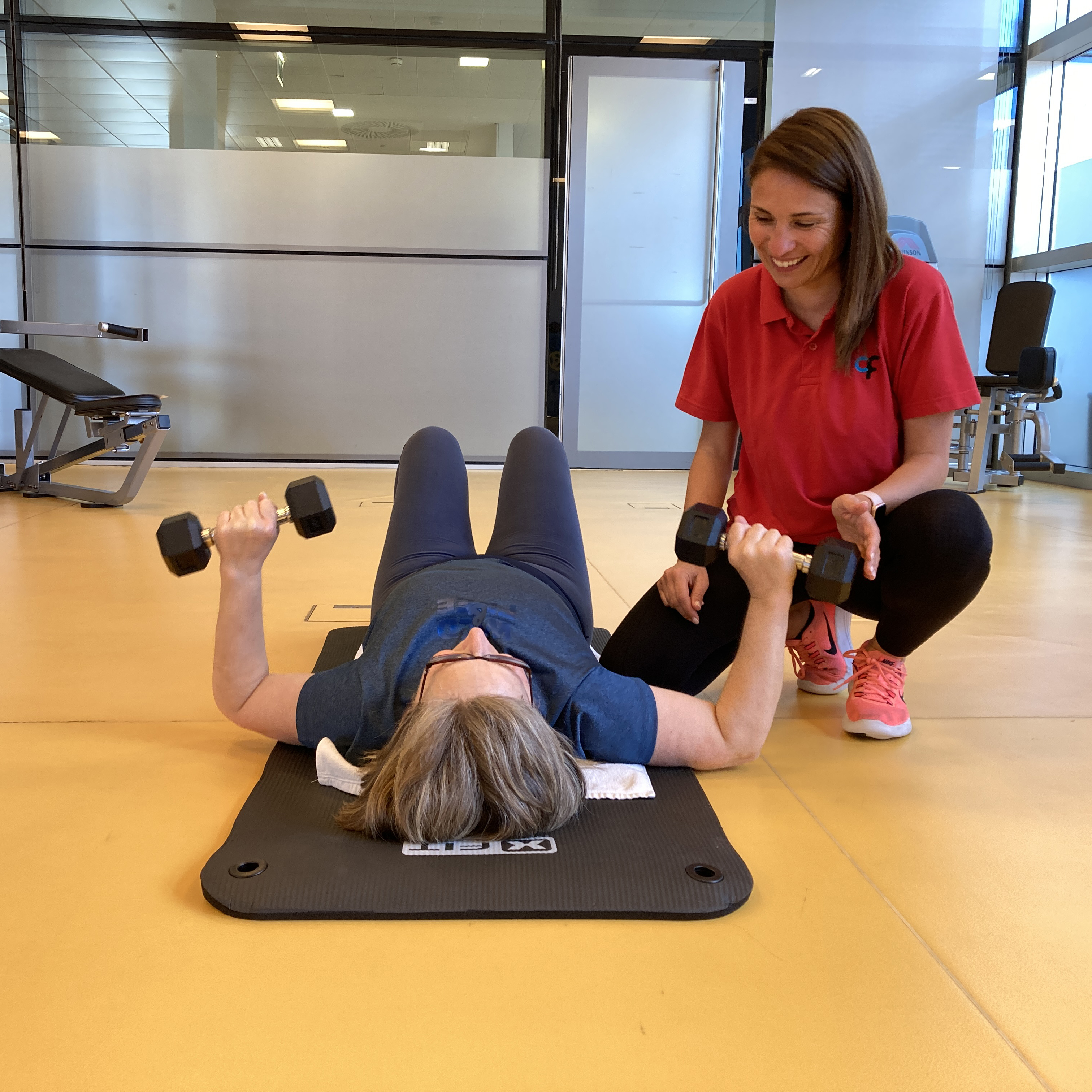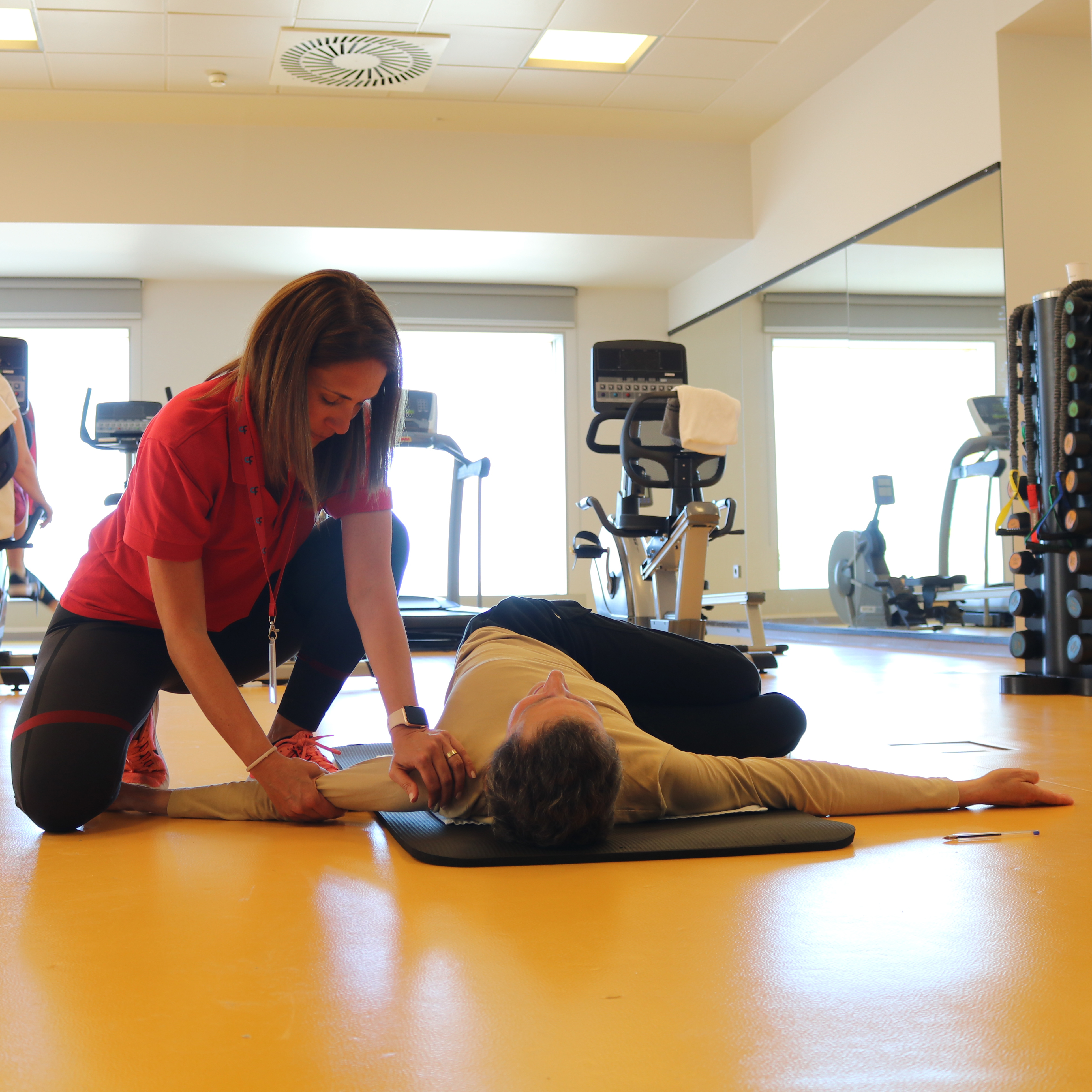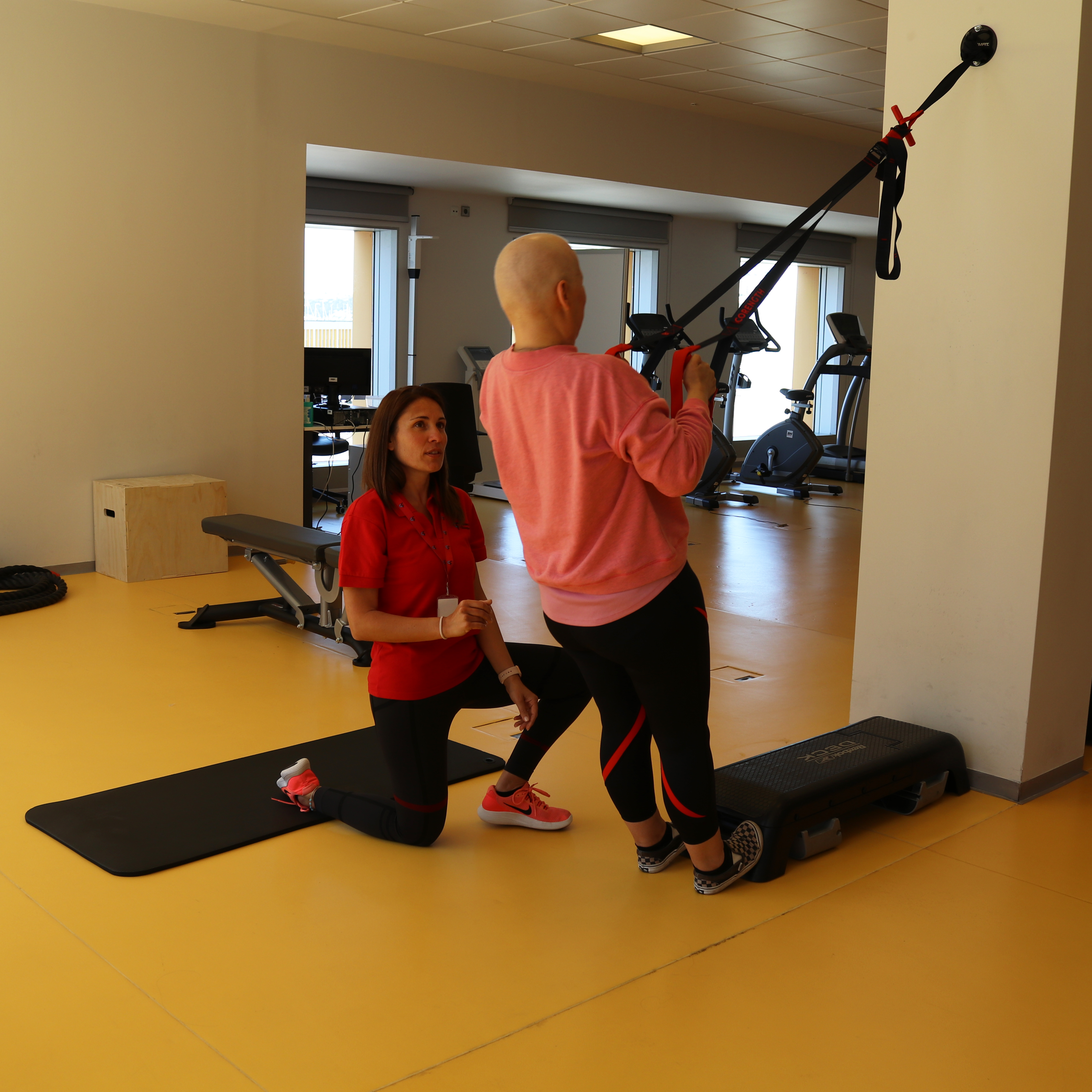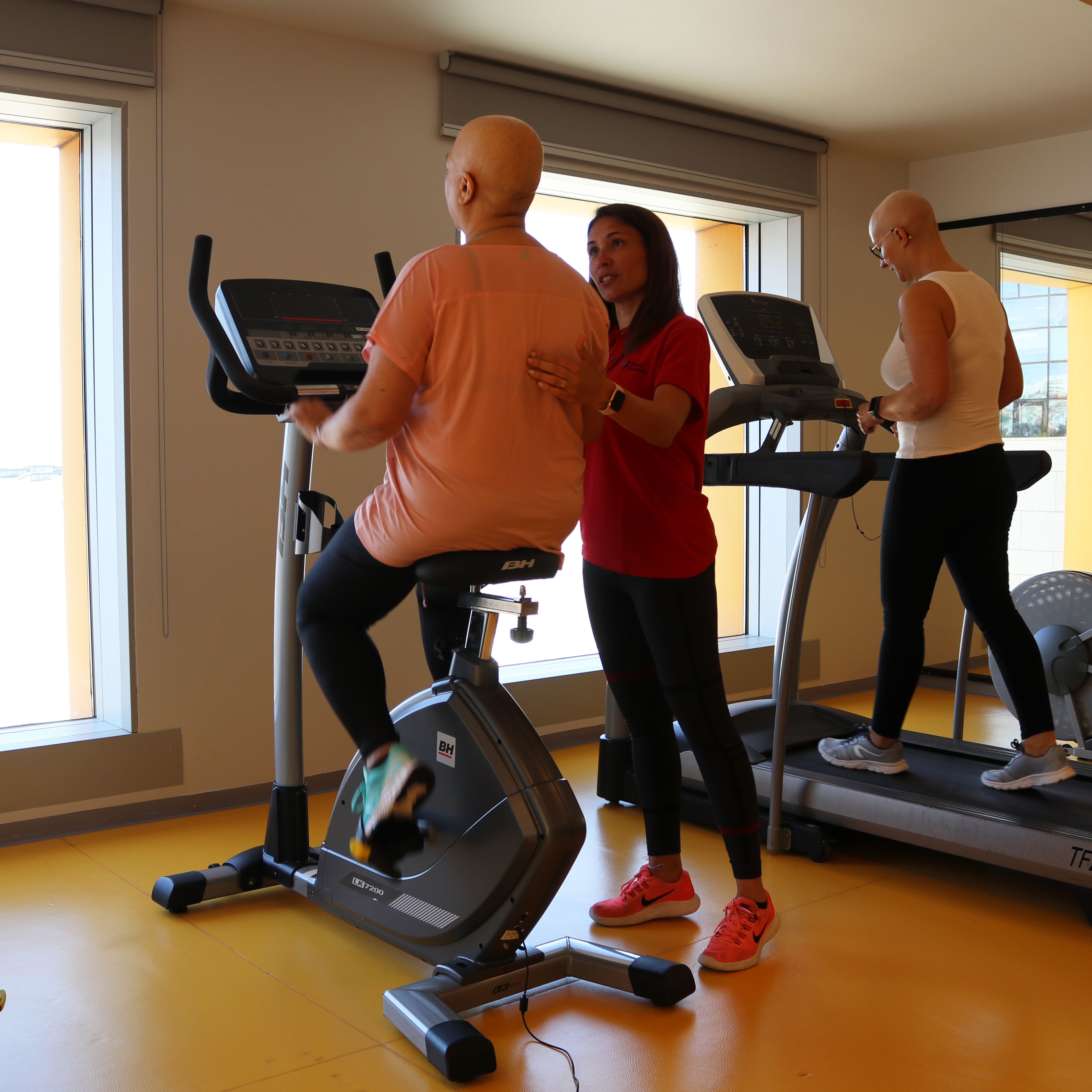Carla Malveiro is responsible, at the Champalimaud Foundation (FC), for implementing oncological patients’ physical exercise programmes, particularly for women undergoing treatment at the Foundation’s Breast Unit. As a doctoral student from the Human Motricity Faculty (FMH) of the University of Lisbon, the 41-year-old exercise physiologist, specialising in oncology, has worked at the Foundation since October. As well as patients referred by the Breast Unit, she also aims to help cancer patients from the other CF Units to tolerate their aggressive treatments better, thus improving their quality of life.
Everyone agrees that physical activity is a determining factor in preventing cancer and other diseases. But what are the benefits for cancer patients?
There is already strong scientific evidence of the benefits of physical exercise in oncology. For example, research shows that physical exercise can help cancer patients to tolerate their treatments better, and that it can minimise the physical decline due to the disease, counter the fatigue they experience (one of the main symptoms reported by patients, with a strong impact on daily activities), minimise anxiety and depression – and most of all, improve quality of life.
You are an exercise physiologist. What is it exactly?
Exercise Physiologists have a graduate or higher degree in Sport Sciences, specialising in exercise physiology, exercise and health, or sport training. In other words, they are the professionals of reference in the area of physical fitness aptitude evaluation and prescription, as well as for the supervision and conduction of physical exercise programmes and the promotion of physical activity and health. Furthermore, being associated with health promotion and disease prevention, as is the case here at the Champalimaud Foundation, the Exercise Physiologist is the natural partner of the clinical teams in the context of multidisciplinary interventions.
You work with women who have breast cancer and are being treated with a combination of chemotherapy, radiotherapy, more or less radical surgery, hormonotherapy, etc. What are the complications of these treatments that can be mitigated by the practice of physical activity?
Oncologic treatments are associated with various side effects. As I already mentioned, fatigue is the effect most frequently reported by patients in the short and long term, mainly when submitted to chemotherapy and/or radiotherapy. Well, people who exercise tolerate fatigue much better than those who don’t. This can seem controversial: if exercising causes tiredness, won’t it be worse to do it than not? However, the tiredness associated with exercise completely differs from the fatigue caused by the treatments. Indeed, most women I follow say that although they are exhausted, exercising gives them an energy boost to continue performing their daily chores and even work.
There are also changes related to body composition, which are very frequent during and after treatments: namely, the reduction in muscle mass (sarcopenia) and bone mass (osteopenia and osteoporosis), as well as potential cardiac complications, that can be attenuated through physical exercise. Specifically, for breast cancer patients, surgery sometimes implies axillary lymph node dissection (removing lymph nodes from the armpit) on the affected side. In this case, there may be complications associated with shoulder mobility and sometimes the development of lymphoedema (swelling of the corresponding arm due to the accumulation of lymph in the tissues).
Are there specific workouts to deal with these situations?
There are and they require individualised prescriptions, which include specific exercises of predetermined intensities and volumes. Evidence-based guidelines recommend that cancer patients be as physically active as their current capacity and physical condition allow. To obtain significant health benefits, they must do at least 150 minutes weekly of moderately intense aerobic exercise – and two to three times a week, moderately to vigorously intense muscular strength exercising of the main muscle groups.
Recently, there was a myth about strength workouts in women with breast cancer, advising that they should not move the affected arm nor carry any weight, because this could lead to developing or worsening lymphoedema. Unfortunately, nowadays, some people still believe this to be true.
In fact, the scientific data and the practical results (which I can vouch for, having more than eight years of experience in direct interventions involving people with this type of cancer), show precisely the opposite. Physical exercise after surgery, as long as it is correctly guided and supervised – including strength workouts – is not only a safe option but an efficient one in reducing lymphoedema, as it potentiates haemodynamic venous responses and lymphatic circulation, thus contributing to reduce swelling.
What about mood and anxiety? Does physical exercise also help, in spite of fatigue?
It does. Exercise leads to the release of endorphins, which give the patient a feeling of well-being and pleasure. Additionally, when the workout is performed under supervision and simultaneously with other cancer patients, as is the case at the Champalimaud Foundation’s gym, the possibility of sharing experiences, and the perception that they are all going through similar processes, acts as a help group and can substantially improve the patients’ potential depressive or anxious states.
Do you also work with patients from other CF Units?
I’m open to working with any patient – although, right now, I only work with breast cancer patients.
Why?
Because the Foundation’s gym, where I work, just reopened last October [it was closed during the pandemic] with our PhD research project, called NeoProgram, which is specific to breast cancer patients being submitted to neoadjuvant treatments [this can be a combination of chemotherapy, radiotherapy, etc., prior to surgery]. Also, as I was already working with doctors from the Breast Unit who advocate and recommend the practice of physical exercise, it became much easier for them to redirect patients to our programmes.
Do the physical exercise programmes depend on the type of cancer?
They do. The prescription of exercise is akin to a medical prescription. It is based on knowing how cancer affects our health and understanding how certain exercises improve the structure and function of our body’s systems. For instance, a patient with prostate cancer has a higher probability of developing urinary incontinence after surgery. So there is a specific type of intervention, which consists of strengthening the pelvic floor muscles. The exercise programme always depends on the type of cancer, on the individual, and on context.
Are the physical exercise programmes carried out before or after treatment?
They can be carried out before or after treatments. It’s never too late to start… Nevertheless, ideally, they should start immediately after diagnosis, given all the benefits I have mentioned.
Do the breast cancer patients you work with usually start at diagnosis?
No. It is understandably difficult to start right away, especially for patients who have never exercised before. When someone has just been diagnosed with cancer, they only think about surviving the disease, not about exercising.
But the truth is that, when doctors can make patients aware of the importance of physical exercise right after diagnosis, patients become much more receptive and choose to start working out. Currently, we mostly work with breast cancer patients before radiotherapy, to help them with shoulder mobility (which is very important to ensure the correct positioning of the patient’s arm on the machine). We even do respiratory exercises essential for radiotherapy protocols, such as the Deep Inspiration Breath-Hold Technique. And we also work with survivours of previous treatments and patients submitted to hormonal treatments. But now, thanks to the NeoProgram, I believe this trend will change.
How are physical exercise programmes structured?
Usually, each session lasts 45 minutes. It is supervised and personalised. The prescription includes mobility and stability exercises, a cardiorespiratory component and a resistance and muscle-strengthening training.
How long do these programmes last?
Their duration is not fixed, but we recommend at least 12 weeks, two to three times a week, to obtain significant results.
Do you think physical exercise should be part of every cancer patient’s treatment plan?
This is my conviction, and the scientific evidence supports it! It is essential that physical exercise is an integral part of cancer treatment plans and that it is always included in our multidisciplinary teamwork. Cancer patients who exercise regularly have less serious side effects from their treatments and a lesser risk of cancer recurrence. That is why physical exercise should be initiated, in a supervised manner, right after diagnosis.
In Portugal, is this already happening in hospitals and cancer centres? Do oncologists see physical exercise as a therapeutic necessity?
In Portugal, there are several programmes and associations where multidisciplinary teams encompass physical exercise as a therapeutic need. However, it is very rare for this work to be developed in clinical settings. Fortunately, the Champalimaud Foundation has already taken that step, which I believe is essential for improving cancer patients' quality of life.
Interview by Ana Gerschenfeld, Health & Science Writer of the Champalimaud Foundation.




